Services 1 | Status Operational Daily ridership 577,000 (Q3 2016) Stations 16 | |
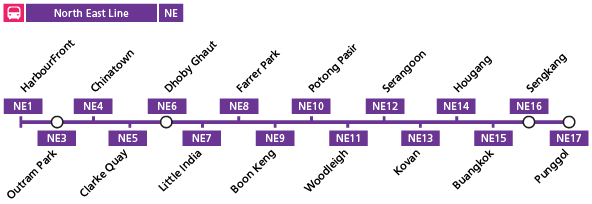 | ||
Opened 20 June 200315 January 2006 (Buangkok)20 June 2011 (Woodleigh) Terminis Punggol MRT/LRT Station, HarbourFront MRT Station Similar Boon Keng MRT Station, Farrer Park MRT Station, Kovan MRT Station | ||
【Singapore MRT/新加坡地铁】North-East Line Route Announcement 东北线路线广播
The North East Line (NEL) is the third Mass Rapid transit line in Singapore and the world's second longest fully underground, automated and driverless, rapid transit line after the Circle Line. The line is the world's first fully automated and driverless underground rapid transit line at 19.2km with 16 stations. Travelling from one end of this line to the other end takes 33 minutes. This line is coloured purple in the rail map.
Contents
- Singapore MRTNorth East Line Route Announcement
- Overview
- History
- Punggol Downtown Extension PGDe
- Busiest MRT Station
- Stations
- Rolling stock
- Train Control
- Line disruptions
- References
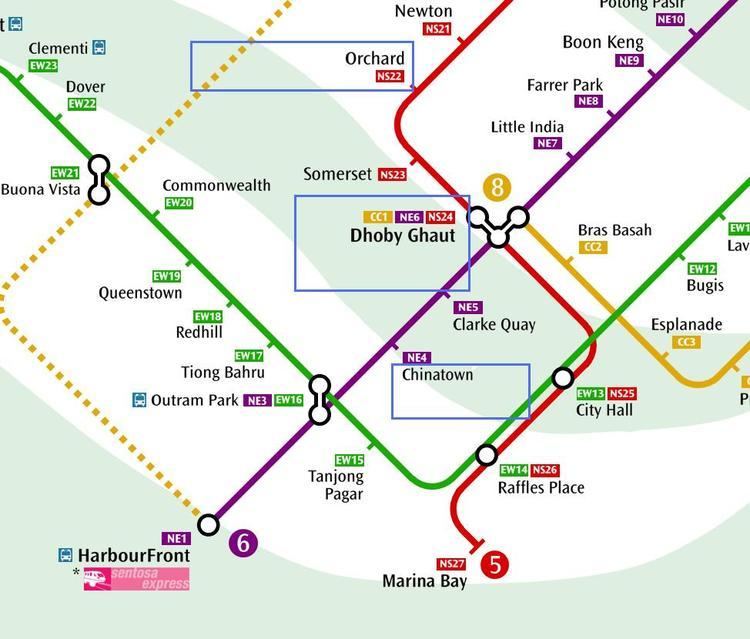
The North East Line is also the first line to feature Art in Transit across all 16 stations.
Overview
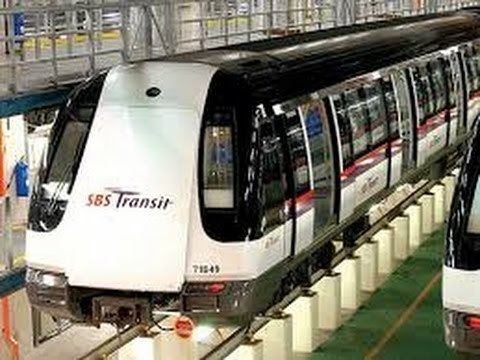
As the name implies, the line connects Central Singapore to the north-eastern part of the island. Transfer to the North South Line is provided at Dhoby Ghaut, to the East West Line at Outram Park and to the Circle Line at Serangoon, Dhoby Ghaut and HarbourFront. The North East Line interchanges with the Downtown Line at Chinatown and Little India. The North East Line will interchange with the future Thomson-East Coast Line at Outram Park. It passes through the busy areas such as Chinatown, Clarke Quay and Dhoby Ghaut (which have historical and cultural value), and through the mature and new residential estates at Potong Pasir, Serangoon, Hougang, Sengkang and Punggol. The North East Line passes through the Eu Tong Sen Street, Serangoon Road, Bendemeer Underpass, Upper Serangoon Road and the Upper Serangoon Viaduct. This line is the first in Singapore to be entirely underground and the first line to be operated by SBS Transit.
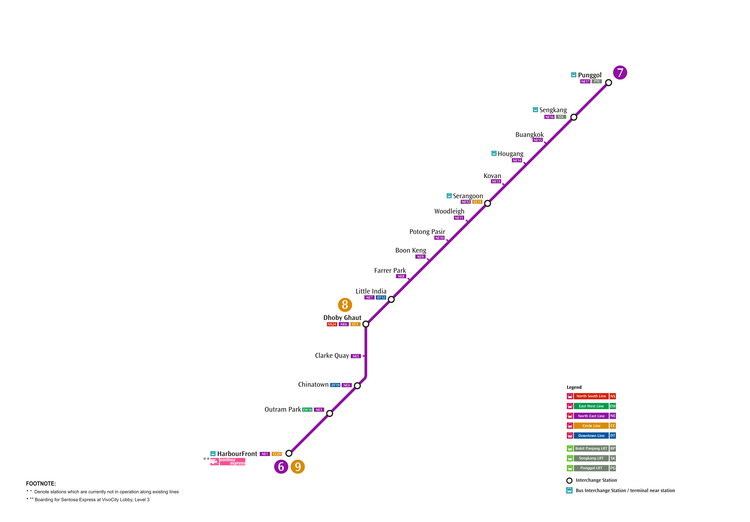
The North East Line is the first line in Singapore to have artwork integrated into all its 16 stations under the Art in Transit programme. Other than the Art in Transit programme, the interior architecture for the stations are typical of the design of the early 2000s with lots of white, glass and steel. This kind of design can be seen in other subway stations built during this period like the Shenzhen Metro and Hong Kong MTR's Tseung Kwan O line.
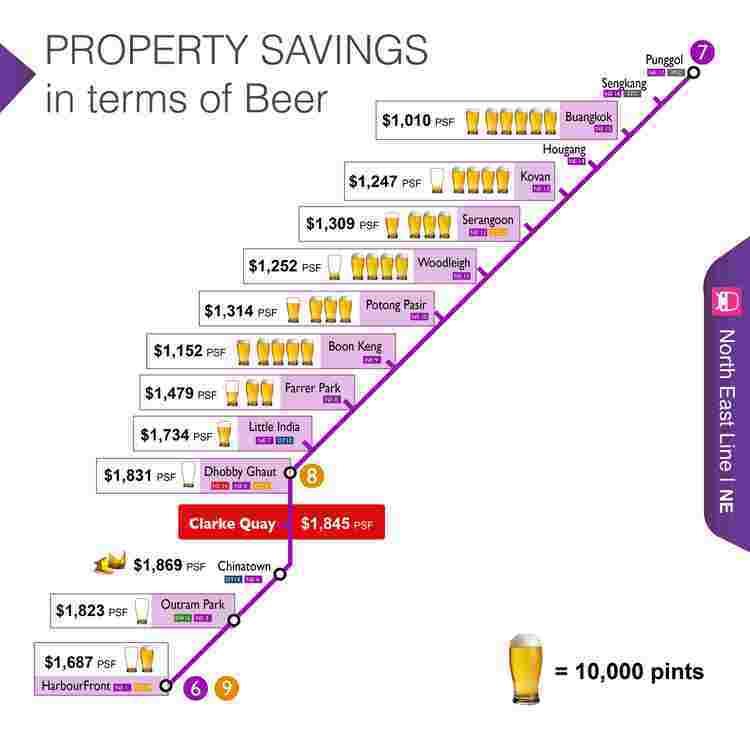
As of 2015, trains operate at two-minute intervals during peak hours, five-minute intervals during mid-day service and six-minute intervals in the early morning and night times.
History

North East Line dates back to 1986, where the Communications Minister Yeo Ning Hong had announced that it would be "feasible to extend the MRT once it is 3 million". The line would have gone from Punggol and Seletar/Jalan Kayu to Outram Park.

In the initial stages of planning, Outram Park was initially planned to be the southern terminus of the North East Line. However, in 1993, the Land Transport Authority decided to extend the line southwards to HarbourFront, after noting that many people liked to go to the World Trade Centre (the present day HarbourFront Centre).
The Land Transport Authority received approval for the construction of the North East Line on 16 January 1996, shortly after the plans were feasible once the Hougang Central Bus Interchange is already opened since 17 December 1994. French company Alstom was chosen as the main contractor and manager of the project. The operating license was given to new rail operator SBS Transit in order to foster competition with SMRT Trains. Construction began on 1 January 1997 and was completed on 20 January 2001, but all the stations had been completed with new signages.
The line was scheduled for completion in December 2002, but due to various problems in the automation, the opening was repeatedly delayed. It was finally opened on 20 June 2003, with higher fares than existing lines supposedly to compensate for the heavy construction costs (S$4.6 billion).
At the time that the line was opened, all of the stations were operating except Buangkok and Woodleigh. SBS Transit announced that these would open only when there was a critical mass of passengers in those areas. With respect to Buangkok, which had already been fully built, the company claimed that the projected number of passengers was too low to cover operating costs. Constant public pressure, notably the "White Elephant" incident and subsequent media attention, forced it to review the situation and the station duly opened on 15 January 2006. The last station on the line, Woodleigh, opened on 20 June 2011 in anticipation of an American International School which is under construction in the vicinity of the station that is slated to open in 2012.
Punggol Downtown Extension (PGDe)
On 17 January 2013, a 2-kilometre extension which will run from Punggol through Punggol North including the new Punggol Downtown was announced. The extension will also serve the upcoming "creative cluster and learning corridor" in Punggol, which will include the Singapore Institute of Technology's new campus. It is expected to be completed by 2030. However, the extension might be completed ahead of schedule due to the rapid development of Punggol North. Engineering consultancy studies have started for the extension.
Busiest MRT Station
Dhoby Ghaut was previously the busiest station on the line. But a week after VivoCity (The largest shopping mall in Singapore) opened, HarbourFront's daily ridership doubled to 60,000 passengers a day, becoming the busiest MRT station on the North East Line.
Stations
The North East Line's numbering scheme reserves station code NE2 between HarbourFront (NE1) and Outram Park (NE3).
Rolling stock
The rolling stock consists of Alstom Metropolis C751A trains, running in six-car formation. These trains operate from Sengkang Depot near Buangkok Station on the North East Line. The Sengkang Depot has maintenance and train overhaul facilities for trains along the North East Line.
In 2010, the government announced that they would be looking to increase the number of trains on the North East Line by 70% within 5 to 6 years to cater to an expected increase in passenger traffic. The new trains are called Alstom Metropolis C751C. 18 trains of six cars each were purchased and housed in Sengkang Depot, and have been in passenger service since 1 October 2015
This is the only line which uses a pantograph system for collecting power from overhead catenary; all other lines take power from a third rail.
Train Control
The North East Line is equipped with Alstom Urbalis 300 Communications-based train control (CBTC) moving block signalling system on the MASTRIA system with Automatic train control (ATC) under Automatic train operation (ATO) GoA 4 (UTO). The subsystems consist of Automatic train protection (ATP) to govern train speed, Iconis Automatic Train Supervision (ATS) to track and schedule trains and Smartlock Computer-based interlocking (CBI) system that prevents incorrect signal and track points to be set. 18 trains of six cars each were purchased and housed in Sengkang Depot, and have been in passenger service since 1 October 2015.
Train Data Management System (TDMS) which concentrate and dispatch the rolling stock information with fixed equipment. The IAGO Waveguide communications network has the capability to transmit video and is almost maintenance-free. Base stations are located within the signalling equipment room.
Automatic platform screen doors supplied by Westinghouse provide safety for passengers, offering protection from arriving and departing trains.
Line disruptions
On 15 March 2012, more than 117,000 commuters were affected during a peak hour train breakdown between Dhoby Ghaut and HarbourFront, caused by faulty overhead power cables at the tunnel of the Outram Park that had snapped. A second problem was discovered relating to electricity insulation, delaying the service further. Train services resumed at 4.35 pm after nearly 10 hours of disruption making it the third breakdown in 4 months. Subsequently, the Land Transport Authority (LTA) intends to impose financial penalties amounting to S$400,000 on SBS Transit for the train service disruption along the North East Line on 15 March 2012.
On 13 October 2015, train service was disrupted between Farrer Park and Hougang for more than half an hour due to a power fault. It was triggered by a malfunction of a component in the electrical switchgear at a substation which caused the main circuit breaker to trip. As an interim measure, SBS Transit has increased the protection setting of the circuit breaker to cater for the projected maximum load of the network.
On 26 October 2015, about 41,000 commuters were affected during morning peak hour when a power fault crippled the whole line from Punggol to Harbourfront stations. This is the first time that both the north- and south-bound service are affected which resulted in the mobilization of about 100 free shuttle buses across the NEL. The Alstom Metropolis C751C train was returning to the Sengkang Depot when the driver saw sparks from above the train and stopped the train at a stretch where the mainline and depot catenary system wires overlap. This resulted in arching between the wires of the mainline and the depot. This caused the catenary system wires to melt and eventually snap. As a precautionary measure, SBS Transit has marked non-stopping areas at all overlapping zones and reduced electrical voltage difference between the catenary system wires at the overlap point, in case trains stop at this stretch.
